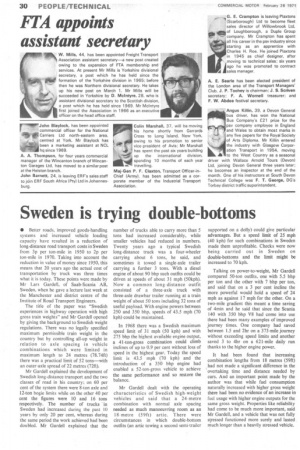Sweden is trying double-bottoms
Page 32

If you've noticed an error in this article please click here to report it so we can fix it.
• Better roads. improved goods-handling systems and increased vehicle loading capacity have resulted in a reduction of long-distance road transport costs in Sweden from 3p per ton-mile in 1950 to 2p per ton-mile in 1970. Taking into account the reduction in value of money since 1950, this means that 20 years ago the actual cost of transportation by truck was three times what it is today. These points were made by Mr Lars Gardell, of Saab-Scania AB, Sweden, when he gave a lecture last week at the Manchester and district centre of the Institute of Road Transport Engineers.
The title of the paper was "Swedish experiences in highway operation with high gross train weights" and Mr Gardell opened by giving the background to Swedish weight regulations. There was no legally specified maximum permissible train weight in the country but by controlling all-up weight in relation to axle spacing in vehicle combinations which were limited in maximum length to 24 metres (78.74ft) there was a practical limit of 52 tons—with an outeraxle spread of 22 metres (72ft).
Mr Garde!l explained the development of Swedish long-distance transport and the two classes of road in his country: on 60 per cent of the system there were 8-ton axle and 12-ton bogie limits while on the other 40 per cent the figures were 10 and 16 tons respectively. The number of trucks in Sweden had increased during the past 10 years by only 20 per cent, whereas during the same period the work achieved had been doubled. Mr Gardell explained that the number of trucks able to carry more than 5 tons had increased considerably, while smaller vehicles had reduced in numbers. Twenty years ago a typical Swedish long-distance truck was a four-wheeler carrying about 6 tons, he said, and sometimes it towed a single-axle trailer carrying a further 3 tons. With a diesel engine of about 90 bhp such outfits could be driven at speeds of about 31 mph (50kph). Now a common long-distance outfit consisted of a three-axle truck with three-axle drawbar trailer running at a train weight of about 50 tons including 32 tons of useful payload. With engine powers between 250 and 350 bhp, speeds of 43.5 mph (70 kph) could be maintained.
In 1968 there was a Swedish maximum speed limit of 31 mph (50 kph) and with 275 bhp the highest available engine output, a 41-ton-gross combination could climb inclines of up to 0.9 per cent without loss of speed in the highest gear. Today the speed limit is 43.5 mph (70 kph) and the introduction of a 350 bhp engine had enabled a 52-ton-gross vehicle to achieve the same performance and so restore the balance.
Mr Gardell dealt with the operating characteristics of Swedish high-weight vehicles and said that a 24-metre combination with normal axle spacing needed as much manoeuvring room as an 18-metre (59ft) artic. There were circumstances in which double-bottom outfits (an artic towing a second semi-trailer
supported on a dolly) could give particular advantages. But a speed limit of 25 mph (40 kph) for such combinations in Sweden made them unprofitable. Cheeks were now being carried out in Sweden on double-bottoms and the limit might be increased to 70 kph.
Talking on power-to-weight, Mr Garda compared 50-ton outfits, one with 5.5 bhp per ton and the other with 7 bhp per ton, and said that on a 3 per cent incline the more powerful would hold a speed of 24 mph as against 17 mph for the other. On a two-mile gradient this meant a time saving of 4min and he said that since the Seania 140 with 350 bhp V8 had come into use there had been many examples of improved journey times. One company had saved between 1.5 and 2hr on a 373-mile journey without exceeding speed limits and another saved 3 to 4hr on a 621-mile daily run thanks to the higher engine power.
It had been found that increasing combination lengths from 18 metres (59ft) had not made a significant difference in the overtaking time and distance needed by cars. And an important point made by the author was that while fuel consumption naturally increased with higher gross weight there had been no evidence of an increase in fuel usage with higher engine outputs for the same gross weight. Properties like reliability had come to be much more important, said Mr Gardell, and a vehicle that was not fully stressed functioned more surely and lasted much longer than a heavily stressed vehicle.




























































































